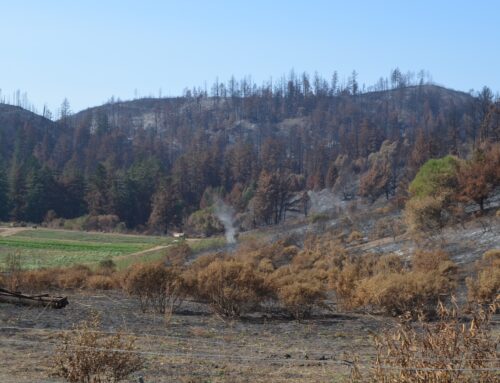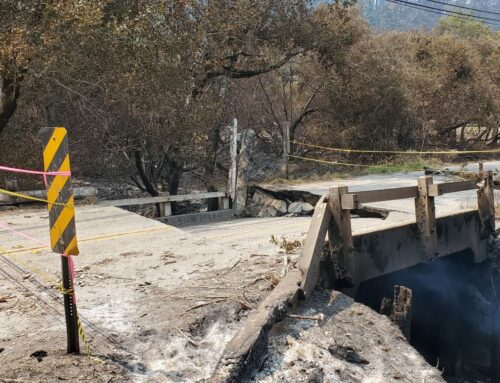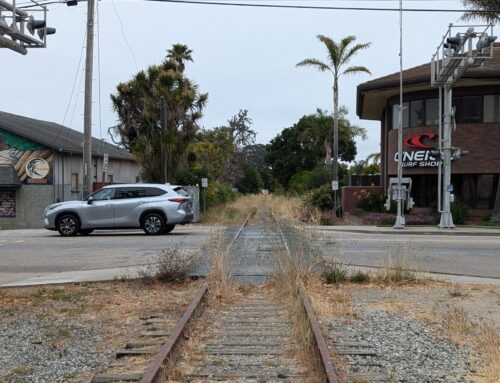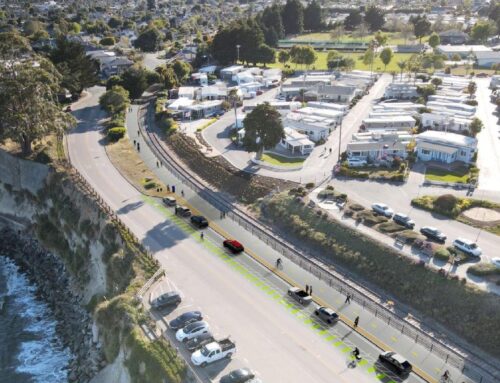Santa Cruz Local offers stories on local environment free as a public service. But journalism can be expensive — and deep, time-consuming, investigative journalism is the most expensive of all.
Santa Cruz Local depends on memberships from people like you to make sure vital information can be available to all. Can we count on your help?
SANTA CRUZ >> After years of public input, a Santa Cruz County plan to limit the redevelopment of oceanfront homes and change rules on new seawalls and other coastal development will be considered by the California Coastal Commission in the coming months.
If the Coastal Commission accepts changes to a Local Coastal Program that was approved unanimously by Santa Cruz County supervisors in September, the county will be on the vanguard of local governments in the state that are trying to manage expected sea-level rise. The changes try to strike a balance between sea-level-rise management, beach access and oceanfront property owners’ rights to redevelop and protect their homes.
The proposed Local Coastal Program for unincorporated Santa Cruz County will provide new rules for about 1,000 oceanfront properties that are often worth millions of dollars. Up to 90% of the oceanfront properties also are second homes, county staff said. However, some senior citizens and retirees who live in those homes worry about potentially reduced property values with stricter building rules.
If approved by the Coastal Commission, the county will be the first in California to adopt planning and infrastructure regulations that explicitly address sea-level rise. Counties like San Mateo and San Diego have struggled with it.
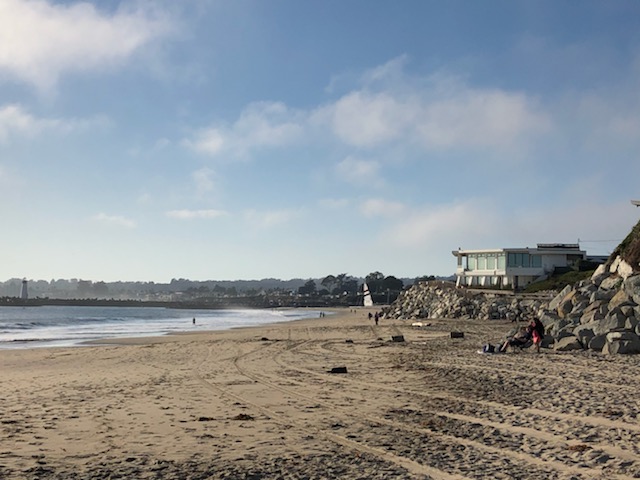
“It may be very difficult to create a document that has universal consensus or buy-in,” said Santa Cruz County Supervisor Zach Friend. Friend’s district includes Seacliff, Rio Del Mar and La Selva Beach.
“Receiving the Coastal (Commission) feedback will allow us to continue that discussion to see if we can create a model across the state that can be used,” Friend said. “I know other communities are going to be looking to us as a guiding document.”
Where the plan applies
- The Local Coastal Program amendments include the “first row of houses on the coastal bluff overlooking the beach or ocean, and houses actually on the beach,” said Santa Cruz County Resource Planner David Carson. Unincorporated areas of the county stretch from the North Coast to the Monterey County border. The cities of Santa Cruz and Capitola have their own Local Coastal Programs.
- The major changes in the county’s latest Local Coastal Plan apply to the coast from the Santa Cruz Small Craft Harbor to the west edge of the city of Capitola.
Key points of the Local Coastal Program
- The program provides a thorough study of the coast from the Santa Cruz Small Craft Harbor to 41st Avenue. It evaluates the long-term viability of East Cliff Drive and whether coastal armoring is appropriate.
- The program creates a “shoreline protection area” of about 1.5 miles from 41st Avenue to the west edge of Capitola. There, seawalls and other coastal armor will be allowed to protect property on the bluff if county requirements are met.
- In the shoreline protection area, it allows stairs on seawalls and lateral walkways to provide more public access to the coast and beaches.
- One of the program’s aims is to, “Ensure that public access to the coastline and coastal dependent resources is preserved, and take actions to require correction and/or mitigation if the loss of such access and/or resources results from activities or inaction by private property owners,” the plan states.
- It creates Geologic Hazard Abatement Districts where neighbors in unincorporated areas such as Live Oak and Pleasure Point can collectively pay for flood-control projects with finance options.
- It allows the removal of rip-rap (piles of large boulders) between Opal Cliffs and Capitola while replacing them with vertical sea walls.
- It includes a “one and done” policy. Homes destroyed by the ocean can be rebuilt only once.
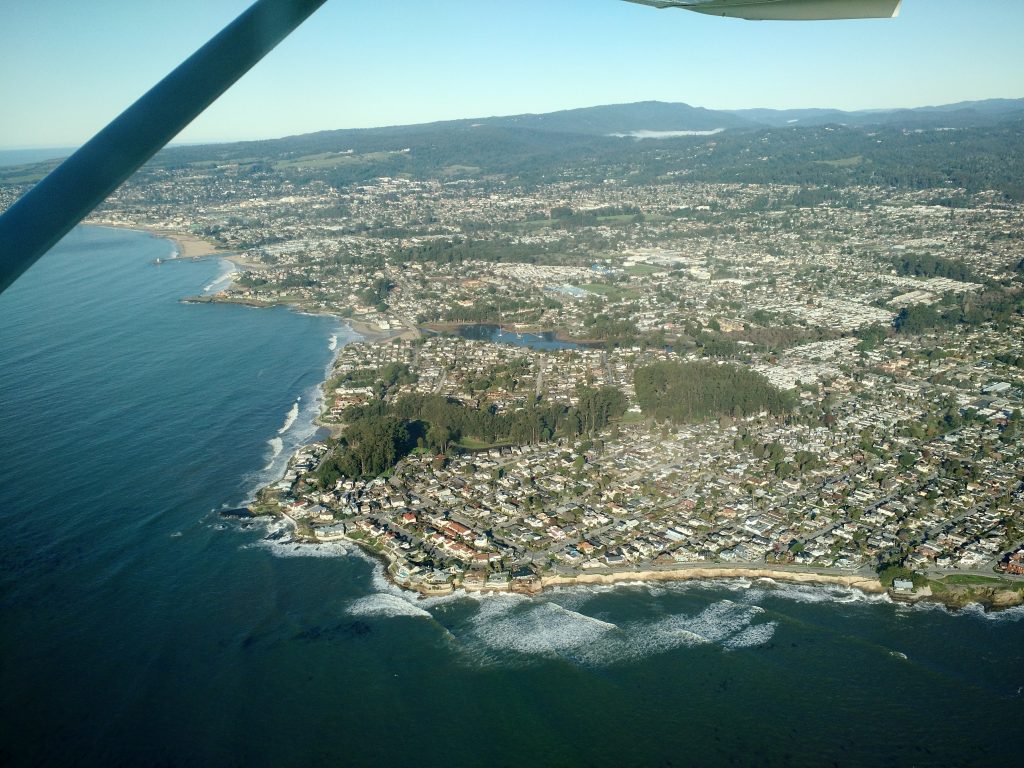
‘Repetitive loss’ changes
One big change in the plan is the “one and done” or “repetitive loss” rules for homeowners.
“If a house gets knocked out by coastal processes, the homeowner can rebuild. But, if it happens again, it’s over and they would not be able to rebuild,” said Santa Cruz County Supervisor John Leopold. Leopold represents Live Oak and Pleasure Point, among other areas.
For the owners of dozens of oceanfront houses on Beach Drive in Rio Del Mar, sea-level rise from melting polar ice caps mean that the ocean is expected to claim those homes if there is no protection. “With incoming sea-level rise, we are not going to be able to stop Mother Nature from taking these homes,” Leopold said. “It is hard to get people to accept this finite time limit.”
Because the Coastal Commission must approve Santa Cruz County’s Local Coastal Program updates, Leopold presented key pieces of the program at the commission’s October meeting.
The repetitive loss language for houses along the beach applies to the coast from the Santa Cruz Small Craft Harbor to Capitola. The rule generally attempts to satisfy the Coastal Commission’s preference for “managed retreat.” Managed retreat policies essentially state that once oceanfront homes and other buildings are threatened by coastal erosion or rising sea levels, they should be relocated or removed to accommodate increased public demands on coastal resources.
Also related to coastal armoring, the Local Coastal Program deals with places like East Cliff Drive at the crossings of Schwann Lake, Corcoran Lagoon and Moran Lake in Live Oak.
During large winter storms, seawater sometimes floods East Cliff Drive in those areas and authorities close the road. The program states that it is not appropriate to build “hard armoring structures” that divert or block flood waters or that artificially modify lagoon areas.
“Future sea level rise may require that bridges be built to cross the lagoon frontages, if it is necessary to maintain the East Cliff Drive transportation corridor in either the current or a nearby/modified road location. Such bridges would be designed to maximize lagoon function.”
Proponents and opponents
The proposed refashioning of such a significant stretch of Santa Cruz County has prompted vehement opposition that generally falls into two camps.
The first camp is mainly environmental groups such as the Surfrider Foundation that oppose the program because of environmental concerns. This group argues that further armoring the Santa Cruz County coast will cause more beach erosion and deprive the public of a valuable recreational resource by favoring the needs of a few oceanfront homeowners.
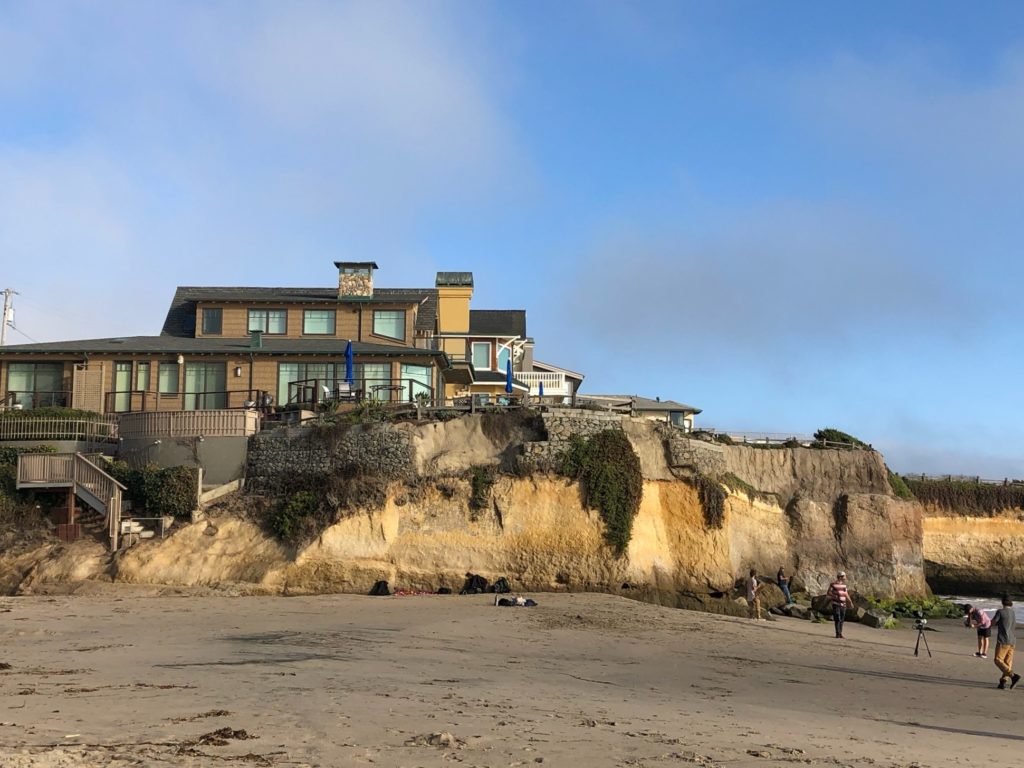
The second camp cites private property concerns. Some homeowners, architects and builders have argued that removing the ability of property owners to protect their homes from floods — while giving county planners authority to effectively condemn a property — infringes on property rights.
A statewide problem
Prior to Leopold’s presentation to the Coastal Commission this month, Sonoma County Supervisor Lynda Hopkins offered a cautionary tale for oceanfront landowners in Santa Cruz County. Some coastal areas in Sonoma County are receding up to one foot per year, according to scientists at the Scripps Institution of Oceanography.
At Gleason Beach, about 4 miles north of Bodega Bay, a cliff overlooking the Pacific eroded so rapidly in late 2017 that 10 houses there fell into the ocean or were irreparably damaged. A stretch of Highway 1 had to be temporarily closed. No one was injured.
“Septic systems and various parts of the house just fell into the intertidal zone,” Hopkins said.
She called the process “unmanaged retreat.”
Another nearby home was relocated, two other homes were deemed uninhabitable and eight more remained on the cliff, according to the Santa Rosa Press Democrat.
Coastal Commission scientists estimate the sea level will rise in California by five and half feet by 2100. It could be more. When compared to the 8-inch rise in global mean sea level over the past century, the future encroachment of the sea into land is predicted to accelerate.
Another way to handle sea level rise is with coastal armoring.
Coastal armor methods include:
- Building vertical sea walls
- Using rip-rap, rubble or other rock-based breakwaters
- Using buried sea walls known as revetments
- Trucking in sand to constantly replenish vanishing beaches
- Constructing sand dunes to try to mimic natural coastal buffers
There are many issues with these strategies that range from the cost-effectiveness of trucking in sand to the ecological harm created by the creation of new sea walls, revetments and rip-rap.
“Coastal armoring causes beach erosion,” said David Revell, a Santa Cruz-based coastal scientist. Rip-rap take up enormous amounts of the beach, while vertical sea-walls prevent the waves from dropping sand, leading to beach erosion at the wall base. “The walls have a tendency to accelerate long-shore currents that increase sand transport away from the structures and down the coast,” Revell said.
In other words, the more private property owners are allowed to build walls to protect their houses from a rising sea, the more coastal erosion can be accelerated and the loss of public beaches.
“We know the greatest threat to equitable coastal access beside sea level rise itself is the continued armoring of our coast,” said Jennifer Savage, a policy manager with the Surfrider Foundation. “What keeps getting referred to as shoreline protection is actually beach destruction.”
The Surfrider Foundation is one of a handful of environmental groups that advocate the coastal commission’s emphasis of managed retreat as the sole approach to grappling with sea level rise.
Because beach access is of paramount importance for the commission’s mission to enforce the Coastal Act, they need to side with the public right to enjoy the coast over the private person’s right to protect their property, they argue.
Coastal Commissioners respond
Some commissioners appear amenable to the argument.
“Armoring should be a last resort because there are impacts to the coast and we lose beaches as a result,” said Coastal Commissioner Sara Amizadeh.
Coastal Commissioner Danya Bochco agreed. “Our obligation is to the people going to the beach over the people living on the cliff,” she said.
Leopold appeared before the commission in an attempt to persuade commissioners that managed retreat should not be the sole strategy.
“That’s one response, but here in Santa Cruz County we have different geology and different conditions up and down our coast,” Leopold told Santa Cruz Local. “We tried to take a more nuanced approach that takes into account different areas and their specific problems to come up with a broader suite of policy approaches.”
The county’s proposal acknowledges sea walls are not appropriate for rural areas or places like Pajaro Dunes in South County where sand dunes provide a more stable natural buffer. But Leopold believes just allowing neighborhoods like Opal Cliffs to slowly fall into the sea is not an ideal approach either. The plan allows for the armoring of that stretch of coast. It performs studies on how best to preserve East Cliff Drive from the harbor to Pleasure Point and the neighborhoods on either side.
“Most of it is already armored, number one,” Leopold told Santa Cruz Local. “If we just allow the coast to deteriorate, there won’t be more coastal access — just mismanaged retreat.”
Mark Massara, an attorney who has long worked on coastal issues, agreed. He’s in favor of the proposed Local Coastal Plan update not only because it strikes a balance between environmental and private property concerns, but because he said it can bring about more coastal access.
“Whether it’s Pleasure Point or Rockview, I am convinced you should allow private property owners the ability to fix up those seawalls and install walkways at the same time that could revolutionize public access in the area,” Massara said.
The sea wall at Pleasure Point, with its stairways down to the ocean and ample viewing spaces for the public, represents the ideal mixture of keeping the power of the ocean at bay while affording the public enjoyment of the coast, Massara said. Before a stairwell was built to the ocean at East Cliff Drive and 33rd Avenue in Pleasure Point, surfers climbed down the cliff with a rope.
Property owners’ takes
Some property owners and builders see the Local Coastal Program as a way to take away property rights.
Cove Britton is an architect who has many clients in the coastal zone — some of whom are not as well-heeled as those who frame the issue. “This isn’t about rich people versus poor people,” Britoon said. “It’s about people’s ability to protect their homes.”
For Britton, one of the most galling aspects of the proposed Local Coastal Program update is that it vests the Santa Cruz County planning department with the authority to choose which properties are allowed to be maintained and which must be left to the ravages of the sea.
“It’s ludicrous,” he said. “It grants far too much authority to local county staff over the process by which a property owner can obtain flood protection.”
Santa Cruz County should not be at the forefront of developing plans to combat sea level rise, Britton argued. He said he would like to see county officials resist the policy prescriptions from the Coastal Commission rather than incorporate them.
“I want them to push back on the coastal commission and question the level of competence the coastal commission has on the issue,” Britton said.
He’s not convinced that building a sea wall means a loss of a beach. He grants the sand at the base of the wall will vanish, but that sand might get pushed down the coast and create other beaches that could turn into public resources.
An example is Seabright State Beach. A narrow stretch of shore, it was turned into one of the sandiest beaches in the region after the creation of the Santa Cruz Small Craft Harbor in the early 1960s. Its jetties altered the local oceanic behavior and sand flow.
“It’s not axiomatic that we won’t have beaches if we build seawalls,” he said.
Beyond sea level rise, several factors play into coastal erosion and the size of beaches, including how much sand rivers deposit and the size and direction of storms, according to U.S. Geological Survey researchers.
Leopold, the county supervisor, said the coast is too diverse and dynamic for an overarching policy to make sense. He said a policy that takes into account the geologic diversity along the county’s coast — from cliffs to beaches to sand dunes — makes the approach more nimble and effective.
Yet more property owners have expressed concern about the proposed planning update and more will likely come forward as the plan nears approval at the Coastal Commission.
“Sea level rise is going to be one of the most difficult and controversial issues we face,” said Coastal Commissioner Donne Brownsey.
Next steps
Coastal Commission staff is expected to review Santa Cruz County’s Local Coastal Program and suggest revisions to the county before the commission puts it on an agenda to consider approval.
Coastal Commissioners Aminzadeh, Brownsey, Bochco and Caryl Hart all expressed skepticism toward local plans that include any coastal armoring.
“I worry that if we hang our hat too much on armoring and sea walls we are not helping the public accept the reality of things and the natural processes that are underway,” Aminzadeh said.
Coastal Commission Executive Director Jack Ainsworth indicated the staff is at least willing to consider the type of compromise Leopold and the Santa Cruz County are offering.
“We have to recognize that in the short term we simply don’t have the systems nor the funding in place for any large-scale managed retreat,” Ainsworth said. “Until we figure that out we may have to have some shoreline protection in certain areas to provide that bridge to the future.”
The comment bodes well for Santa Cruz County’s plan. Ainsworth doesn’t have a vote on the commission, which has repeatedly demonstrated a willingness to buck the recommendation of staff to do what it feels necessary to uphold the Coastal Act.
Many coastal commissioners are skeptical about whether any sea armoring is a solution that is not only temporary but futile when confronted with the relentless power of the ocean.
Because the ocean level inevitably will rise and claim land, Aminzadeh said, “It’s not a question of managed retreat or not. At some level, it’s a question of managed retreat or unmanaged retreat.”
Matthew Renda is a freelance writer who has garnered multiple awards for his reporting. His work has appeared in the Santa Cruz Sentinel, the Mercury News, CNET, CBS News, The Atlantic and Outside Magazine. He lives in Watsonville with his wife, Jessica, and their two children.
Stephen Baxter is a co-founder and editor of Santa Cruz Local. He covers Santa Cruz County government.



